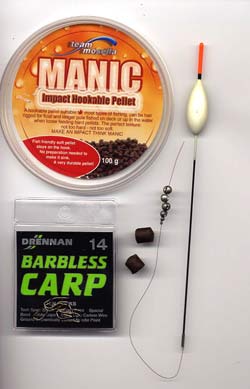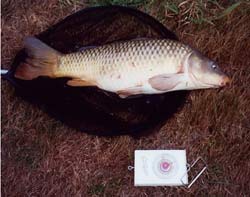| MARK WINTLE |
| Mark Wintle, an angler for thirty-five years, is on a quest to discover and bring to you the magic of fishing. Previously heavily involved with match fishing he now fishes for the sheer fun of it. With an open and enquiring mind, each week Mark will bring to you articles on fishing different rivers, different methods and what makes rivers, and occasionally stillwaters, tick. Add to this a mixed bag of articles on catching big fish, tackle design, angling politics and a few surprises. Are you stuck in a rut fishing the same swim every week? Do you dare to try something different and see a whole new world of angling open up? Yes? Then read Mark Wintle’s regular weekly column. |
FICKLE CRUCIANS
| Through August, I had been trying to figure which species to target as my next big fish challenge. At first perch were on the agenda. Then we had a heatwave, I got distracted having fun catching carp off the top, fitted a trip to the Thames in, and still couldn’t quite figure what to go for. Then I had a stroke of luck. It started like this. Fancying an evening floatfishing on the lake adjacent to the one I earlier tried for tench, I gave it a go. The target was anything that came along. This lake has a heavy stock of carp from 4 to 25lbs, plus loads of tench up to 8lbs, bream, roach and rudd. It also has crucians that run to nearly four pounds. I tried fishing for these crucians at the start of the season but with gin clear water nothing was feeding very well at all. I got a few rudd and a lucky carp. But two months later all the fish in the lake had got their heads down. Furthermore, the lake now had plenty of colour, and that first evening there was a strong breeze blowing.
The First Session With the waggler tripping against the wind I set the float over depth in the six foot deep swim about ten yards out. This slowed the progress of the float with the undertow by dragging the pellet slowly along the bottom. After a quiet first half hour I started to get shy and unhittable bites. There would be a little lift then the float would nearly submerge. I tried hitting the bite at different stages, moving the bottom shot, deepening or shallowing up; all to no avail. Then a slow bite resulted in a lively tench of about three pounds. Shortly after, I lost two fish that felt like tench or crucians, both coming adrift a few seconds after hooking. After this, the carp moved in for over an hour, but the trouble was they were moving through in a way that I kept foul-hooking then losing them. After landing one of about six pounds that was fairly hooked it was back to the funny bites. Eventually I hit one and, after a short scrappy fight, landed it. It appeared to be a cracker of a crucian. I did a quick scale and fin check, and it seemed Okay but the colouration was on the pasty side. The shape wasn’t quite right either. I quickly weighed and photographed it. 2-12, not bad at all. I decided to return on the Saturday for some more of this to see if I could get more crucians. Second Attempt and a Bonus Carp Saturday dawned and I got to the lake soon after it opened. This time I tackled up with a Normark Specimen Match rod and the same line and rig. I felt confident of landing carp with the more powerful rod. The conditions were different with the lake like a millpond. On the surface pods of carp were constantly moving around in the middle about thirty yards out. Again, a slow start preceded the first signs of life in the swim. The first deliberate bites after an hour resulted in a brace of bream around three pounds apiece in quick succession. After this, the swim died for about three hours. I tried to elicit some interest from the cruising carp by firing out floating pellets but they were seemingly uninterested. It became hot and uncomfortable in the still humid air.
After this, the swim came to life in fits and starts. I got a tench of around three pounds and lost another carp of about five or six pounds. All the while I got lots of tiny lifts and dips on the float. Just before packing up mid afternoon I finally connected with one of the little indications and got a crucian of 2-8. As with the previous fish it is a bit on the pasty side, yet the scale count looks good. Two other anglers have been fishing for crucians further along the bank. Despite plenty of bites they had yet to get a crucian when I left, though they were getting carp action. Third time lucky? With the Monday being a bank holiday, I decided to have another go at the crucians. I knew that they were in the swim but how could I improve my bite detection? I toyed with the idea of using a pole but didn’t fancy hooking a double figure carp on it. I compromised by using a 20ft rod with a pole float. I fished it like a pole so the float was right under the rod tip. I stuck to the same 4lb running line and size 14 hook with pellet as bait. This time John Levell, the keeper on the estate, turned up shortly after I started fishing in the early afternoon. He has long been a fan of the crucians in the lake and we discussed tactics. His preference is for bread as bait with pellet as feed. I decided to keep to the pellet on the hook and follow his advice to be very sparing on the feed so the carp are less likely to barge in and push the crucians out (some hope!). He also told me that the two anglers crucian fishing on Saturday did eventually get some crucians, landing six to just over three pounds, but only landed their first fish after eight hours fishing.
Tactical Lessons I have learned a lot during these three sessions. Perseverance is needed for the crucians. A better method is needed to catch the carp (some anglers are getting up to ten a session) though they were not my target. Feeding is key to avoiding the carp; one tactic might be to feed two areas in the swim, one heavily to draw the carp, one very lightly for the crucians. The crucians often give their presence away with little bursts of bubbles, just two or three at a time. Finally, the adapted pole tactics using a long rod has its merits, especially for precision bait presentation and bite detection. I used no. 10 shot to get the correct show of tip, about a quarter inch. This show varies according to how the wind is blowing, and consequently the lake is towing. I needed another no. 10 shot when the tow was non-existent, taking it off when the wind got up. The following weekend I had another go and got two more of the pasty coloured fish. At 2-15 and 2-0 they were far from small but the colouration and body shape hinted that in this lake at least there is a mixture of true crucians, brown goldfish and possibly hybrids of the two. With photographic evidence of the fish, it’s time to investigate further, and so next week I’d like to look into the tricky world of crucians and brown goldfish, and their hybrids. NEXT WEEK: ‘True Crucians?’ |
















